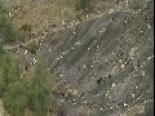 |
The Best Crazy Video Site
|
Is it the pilot? Bones and a parachute found near eerily preserved plane that crashed in Sahara desert 70 years agoBid for survival: The P40 Kittyhawk was found perfectly preserved and someone had apparently tried to build a shelter beside it The 12 human bones were found on some rocks three miles from the wreckage A piece of parachute and a metal button dated 1939 were found nearby Flight Sergeant Dennis Copping crashed at the spot in 1942, and is thought to have wandered off into the desert The perfectly preserved plane was found earlier this year by Polish oil exploration workers Mounting evidence: The twelve bones were found three miles found the plane, along with a piece of parachute, keyfob and metal button with 1939 on it A body has been found in the desert close to the spot where a pilot disappeared after crash-landing during the war. The wreckage of the P40 Kittyhawk plane was found perfectly preserved earlier this year, 70 years after the accident, and now it seems that airman Dennis Copping's remains may have been recovered nearby. The bones were located on some rocks four months ago, along with a piece of parachute, about three miles from where the plane landed in the Sahara desert in 1942. Bullet holes: The Kittyhawk appears to have been shot at (left), while its broken propeller lays nearby. Historians have described the find as the 'aviation equivalent of Tutankhamun's Tomb' A keychain fob with the number 61 on it was found near the remains, along with a metal button dated 1939. But the pilot's relatives claim the Ministry of Defence said that the remains were not those of the lost airman. It has since been established that the bones were never recovered or analysed, leaving open the possibility they may be those of Flight Sergeant Copping. Family memories: William Pryor-Bennett is the nephew of Flt Sgt Copping His nephew, William Pryor-Bennett, from Kinsale, County Cork, Ireland, has now urged for DNA tests to be carried out as soon as possible. To that end, two British historians and a forensic anatomist have volunteered to travel to Egypt and recover the bones themselves. Mr Pryor-Bennett, 62, said he is 'appalled' at the way the matter has been handled. Second World War weaponry: The machine gun on the wing of the crashed plane. It appears the pilot got into trouble and brought it down in the middle of the desert He said: 'The bones suspected to be those of my uncle are apparently still lying in the desert. They were found in June and should have been tested by now. 'Someone from the MoD got in touch with me in August to say that they aren't his bones. 'But it would now seem they have written off the remains prematurely as no DNA tests have been done. I am a little appalled at this. 'They need to be tested as soon as possible. The plane is of no interest to me but he could be buried if it is him. 'This man disappeared long before I was born. My mother and my grandmother used to talk about him and what a nice lad he was. At the controls: The plane's cockpit, but there are fears over what will be left of it after locals began stripping parts and instruments for souvenirs and scrap 'He was a serving his country and who was out there doing his bit. He should be treated properly.' Ft Sgt Copping, 24, was from Southend, Essex, and flew with the 260 Squadron He had been flying between two British bases in Egypt during the north Africa campaign in World War Two when he disappeared. Time capsule: Aside from the damage it sustained during impact, the aircraft appears to have been almost perfectly preserved in the sands of the Sahara Nothing was ever seen of him or his plane again until earlier this year when a team of Polish oil exploration workers stumbled upon the perfectly preserved aircraft. There is evidence to suggest Ft Sgt Copping survived the crash and made a makeshift shelter outside the plane using his parachute. It is thought he died while making a futile attempt to walk out of the desert. Sign of the time: The Kittyhawk's factory stamp (left) and gun loading instruction panel (right). However, some locals see the aircraft as a piece of junk Ready for combat: Flt Sgt Copping proudly looks down from the cockpit of his Kittyhawk P-40 Intact: Most of the plane's cockpit instruments were untouched and it still had it guns and ammunition before they were seized by the Egyptian military for safety reasons Mysterious disappearance: Flight Sergeant Dennis Copping crashed in the desert in 1942, and his plane was only uncovered earlier this year In June this year, a team of historians from Italy unearthed 12 human bones close to an outcrop of rocks, which the Ministry of Defence said were discovered by people who live in that part of the Sahara. Dr Laurence Garey, an independent forensic anatomist, has studied the photographs of the bones. He said: 'I can confirm there are about 12 human bones. There is no question that they are human. Unseen and untouched: Equipment and controls from the plane were found scattered around the craft at the crash site. The plane is still in very good condition 'According to the Italian team they were found just under the surface. Whether they are the bones of Dennis Copping is another matter. 'I can't tell how old they are or how long they have been there without examining them. 'I don't know how or why the Italian team went from the aircraft to the spot where they found these bones but they do seem quite credible. Signs of survival: Flight Sergeant Dennis Copping's parachute was part of what is believed to be a makeshift camp alongside the fuselage 'I hope to be able to recover at least one bone for DNA analysis and to compare that with a member of Dennis Copping's family.' The MoD told Mail Online it had told the family the remains were unlikely to be Copping's because no military clothing was found on the body and it was miles from the scene of the crash. Well-preserved: The Kittyhawk's magazine of bullets were also found in the wreckage. The radio and batteries were discovered out of the plane They said that resources to investigate a discovery in such a remote spot were limited but added that they were still in contact with the family and embassy in Cairo. 'We are aware of this case and understand that investigations are under way in Egypt to identify the human remains,' said a spokesman. 'We are in close contact with Flt Sgt Copping's family and will continue to keep them informed of developments.' Remote: The crash site is about 200 miles from the nearest town. No human remains have been found but it is thought the pilot's decomposed body may lay anywhere in a 20 mile radius of the plane They said they would do more if it begins to look more likely that these are Copping's remains. Captain Paul Collins, the British defence attache in Cairo, claimed they he had had no contact with the Italian team about the find. The P40 Kittyhawk plane has been removed from the desert and locked in a storage crater in El Alemain. The Royal Air Force Museum at Hendon is in negotiations with Egyptian authorities to have the aircraft returned to Britain. Read more: http://www.dailymail.co.uk/news/article-2222406/Dennis-Copping-Body-war-pilot-crash-landed-plane-Sahara-found.html#ixzz2nOsvRrIk Follow us: @MailOnline on Twitter DailyMail on Facebook
Leave a Littlegrey comment:
Please read our Rules on Commenting. Comments that break the rules are subject to removal. Did you know that you can use your Video Fantastica account to chat in The Forums? You must be logged in to leave a comment. Please login or create an account. |
|













0 Littlegrey Comments: